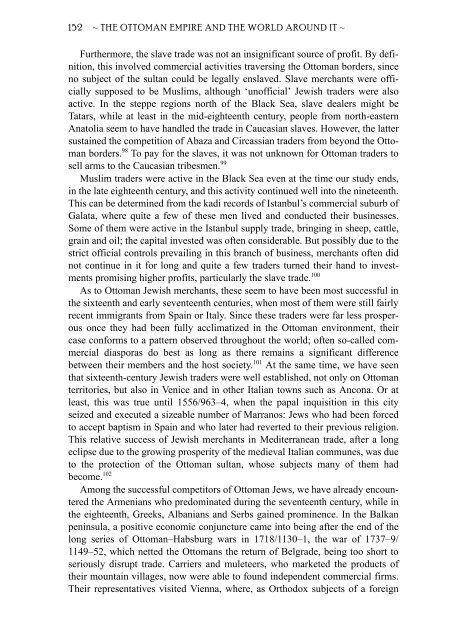The Ottoman Empire and the World Around It - Course Information
The Ottoman Empire and the World Around It - Course Information
The Ottoman Empire and the World Around It - Course Information
Create successful ePaper yourself
Turn your PDF publications into a flip-book with our unique Google optimized e-Paper software.
152 ~ THE OTTOMAN EMPIRE AND THE WORLD AROUND IT ~<br />
Fur<strong>the</strong>rmore, <strong>the</strong> slave trade was not an insignificant source of profit. By definition,<br />
this involved commercial activities traversing <strong>the</strong> <strong>Ottoman</strong> borders, since<br />
no subject of <strong>the</strong> sultan could be legally enslaved. Slave merchants were officially<br />
supposed to be Muslims, although ‘unofficial’ Jewish traders were also<br />
active. In <strong>the</strong> steppe regions north of <strong>the</strong> Black Sea, slave dealers might be<br />
Tatars, while at least in <strong>the</strong> mid-eighteenth century, people from north-eastern<br />
Anatolia seem to have h<strong>and</strong>led <strong>the</strong> trade in Caucasian slaves. However, <strong>the</strong> latter<br />
sustained <strong>the</strong> competition of Abaza <strong>and</strong> Circassian traders from beyond <strong>the</strong> <strong>Ottoman</strong><br />
borders. 98 To pay for <strong>the</strong> slaves, it was not unknown for <strong>Ottoman</strong> traders to<br />
sell arms to <strong>the</strong> Caucasian tribesmen. 99<br />
Muslim traders were active in <strong>the</strong> Black Sea even at <strong>the</strong> time our study ends,<br />
in <strong>the</strong> late eighteenth century, <strong>and</strong> this activity continued well into <strong>the</strong> nineteenth.<br />
This can be determined from <strong>the</strong> kadi records of Istanbul’s commercial suburb of<br />
Galata, where quite a few of <strong>the</strong>se men lived <strong>and</strong> conducted <strong>the</strong>ir businesses.<br />
Some of <strong>the</strong>m were active in <strong>the</strong> Istanbul supply trade, bringing in sheep, cattle,<br />
grain <strong>and</strong> oil; <strong>the</strong> capital invested was often considerable. But possibly due to <strong>the</strong><br />
strict official controls prevailing in this branch of business, merchants often did<br />
not continue in it for long <strong>and</strong> quite a few traders turned <strong>the</strong>ir h<strong>and</strong> to investments<br />
promising higher profits, particularly <strong>the</strong> slave trade. 100<br />
As to <strong>Ottoman</strong> Jewish merchants, <strong>the</strong>se seem to have been most successful in<br />
<strong>the</strong> sixteenth <strong>and</strong> early seventeenth centuries, when most of <strong>the</strong>m were still fairly<br />
recent immigrants from Spain or <strong>It</strong>aly. Since <strong>the</strong>se traders were far less prosperous<br />
once <strong>the</strong>y had been fully acclimatized in <strong>the</strong> <strong>Ottoman</strong> environment, <strong>the</strong>ir<br />
case conforms to a pattern observed throughout <strong>the</strong> world; often so-called commercial<br />
diasporas do best as long as <strong>the</strong>re remains a significant difference<br />
between <strong>the</strong>ir members <strong>and</strong> <strong>the</strong> host society. 101 At <strong>the</strong> same time, we have seen<br />
that sixteenth-century Jewish traders were well established, not only on <strong>Ottoman</strong><br />
territories, but also in Venice <strong>and</strong> in o<strong>the</strong>r <strong>It</strong>alian towns such as Ancona. Or at<br />
least, this was true until 1556/963–4, when <strong>the</strong> papal inquisition in this city<br />
seized <strong>and</strong> executed a sizeable number of Marranos: Jews who had been forced<br />
to accept baptism in Spain <strong>and</strong> who later had reverted to <strong>the</strong>ir previous religion.<br />
This relative success of Jewish merchants in Mediterranean trade, after a long<br />
eclipse due to <strong>the</strong> growing prosperity of <strong>the</strong> medieval <strong>It</strong>alian communes, was due<br />
to <strong>the</strong> protection of <strong>the</strong> <strong>Ottoman</strong> sultan, whose subjects many of <strong>the</strong>m had<br />
become. 102<br />
Among <strong>the</strong> successful competitors of <strong>Ottoman</strong> Jews, we have already encountered<br />
<strong>the</strong> Armenians who predominated during <strong>the</strong> seventeenth century, while in<br />
<strong>the</strong> eighteenth, Greeks, Albanians <strong>and</strong> Serbs gained prominence. In <strong>the</strong> Balkan<br />
peninsula, a positive economic conjuncture came into being after <strong>the</strong> end of <strong>the</strong><br />
long series of <strong>Ottoman</strong>–Habsburg wars in 1718/1130–1, <strong>the</strong> war of 1737–9/<br />
1149–52, which netted <strong>the</strong> <strong>Ottoman</strong>s <strong>the</strong> return of Belgrade, being too short to<br />
seriously disrupt trade. Carriers <strong>and</strong> muleteers, who marketed <strong>the</strong> products of<br />
<strong>the</strong>ir mountain villages, now were able to found independent commercial firms.<br />
<strong>The</strong>ir representatives visited Vienna, where, as Orthodox subjects of a foreign


